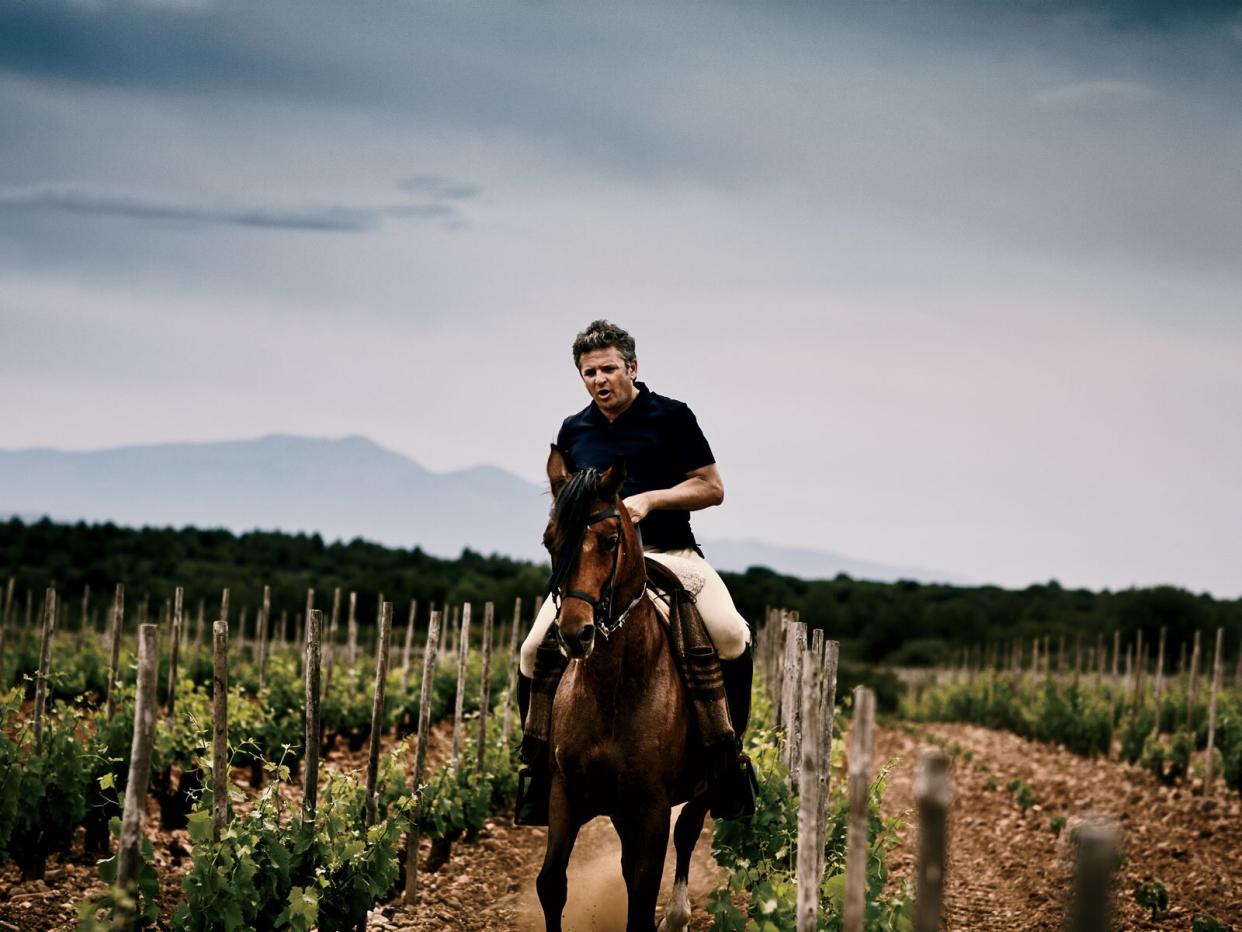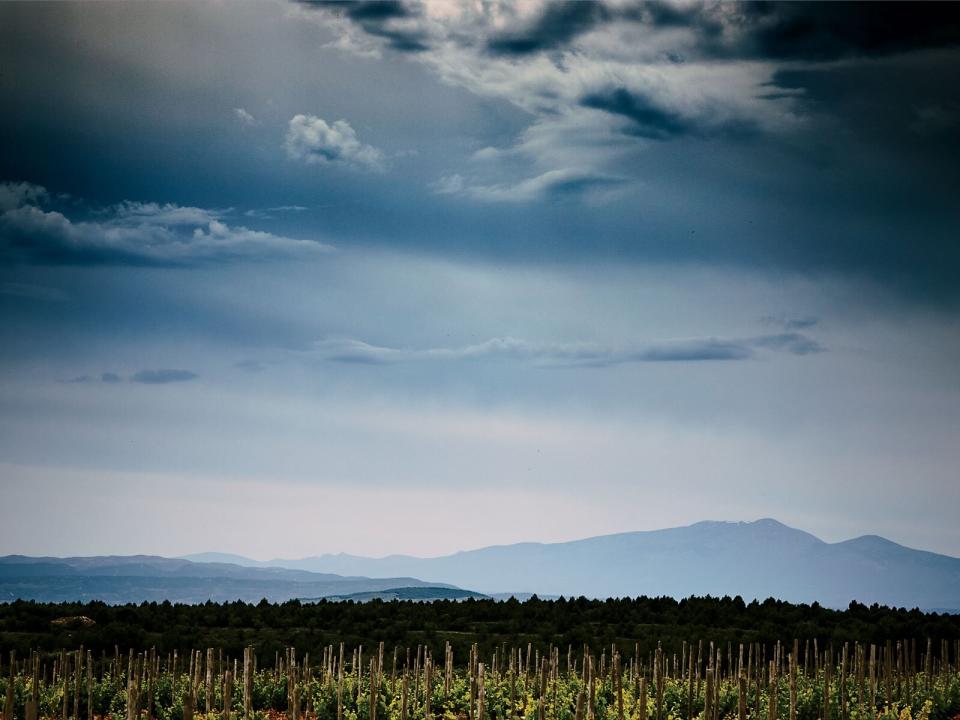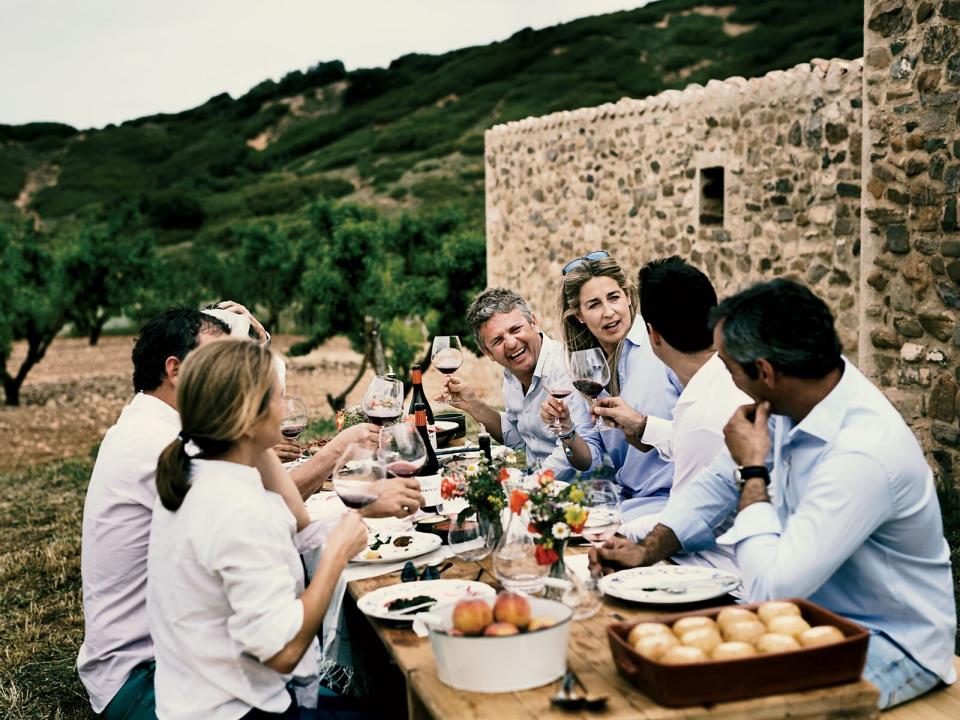Reimagining Rioja With Spain's Most Famous Winemaker

Julian Broad
When Álvaro Palacios isn't making wine in Rioja, the Priorat or Bierzo, or jetting off to conferences in Portugal or tastings in Hong Kong, or touching down for distributor meetings in one of the 90 countries that sells his wines, when he isn't doing any of that—which is basically never—what he likes to do is ride his horse, Califa, in the hills above the Riojan town of Alfaro, where he was born.
Actually, riding his horse is one of two things that Palacios likes to do when he isn't working. The other is to hang out with his childhood friends, eating great food and (as you might imagine) drinking wine. So a Saturday when he gets to do both is a rare pleasure. "My friends ask me, 'When are you coming back to Alfaro?' " he says, unbuckling Califa's girth and taking off the heavy saddle. The horse is lathered with sweat; the hills are steep, the sun is high and they've been riding for three hours now. "I have to tell them, 'Not this week, not the next, not the one after…' But this is what I really love—being here, drinking wine with the people I know."
Here is a remote farmhouse nestled way above the dun-colored plains of Rioja Baja, a few minutes drive from his La Montesa and Valmira vineyards. The place was falling to ruins when he bought it several years ago. Decades before, it had belonged to a shepherd Palacios knew when he was a boy. "He used to walk the five miles into Alfaro with a donkey and a cart to deliver goat's milk," he says. The shepherd slept on one side of the house, his goats on the other. There are no goats in the bedroom these days, but when Palacios rebuilt the farmhouse, he took care to make the place as traditional as possible, down to the chalk mortar between the stones in the walls and the woven cane mats for the ceiling. "There's only one man who can still do that kind of cane work," he says, "a few towns over. He's the only one left."
He adds: "This is a magical place. I always feel like I'm getting in touch with my ancestors here." After hitching Califa to a nearby olive tree, he gives the horse a fond pat on the neck. "They have the biggest lungs, Arabians. He's amazing. He never stops."
One could say that about Álvaro Palacios, too. Partly that's due to geography. If you're the owner of three major wineries in three regions spread across the entire north of Spain, by necessity you're always on the go. "During harvest, I drive 1,200 miles every week," he says. "It's crazy. But what else can you do?"
And so Palacios is constantly moving, constantly working, filled with the restlessness that's innately tied to fierce ambition. Never mind that's he's arguably Spain's most famous winemaker. Never mind that his iconic Priorat red, L'Ermita, is widely recognized as one of the world's iconic wines (and priced as such, at $1,000 a bottle). Despite all the accolades, it's clear that Palacios still feels compelled to make his wines ever better, ever more expressive of the vineyards they come from. Some of that drive is internal, but some is the pressure that comes with reputation. As he says, "L'Ermita is like a great bull that you have to fight every year in the biggest bull ring in Madrid, and you are going to be watched by the hardest critics of bullfighting to see whether you make even the slightest mistake."

Julian Broad
Palacios grew up at his family's winery, Herencia Remondo (now Palacios Remondo) in Alfaro. The seventh of nine children, he began working in the winery's shop by age 10, refilling six-liter carafes with inexpensive Rioja for truck drivers passing through town. Soon after his twentieth birthday, he was helping with the winery's exports, heading off to England, France and the United States. He studied enology at the University of Bordeaux and worked at Stags' Leap Winery in Napa Valley and Château Pétrus in Bordeaux. "My father turned me into the perfect machine," he says. "I had every skill I needed to run the winery, and what did I do? I told him, 'Dad, I'm moving to the Priorat to make my own wine.' I can't imagine how I'd feel if a child of mine said that to me."
Now one of Spain's most famous wine regions, the Priorat back then was an impoverished, mountainous backwater whose wines mostly were sent in tanker trucks down to Valencia to be sold in bulk. But those rocky, remote hillsides were filled with ancient Garnacha and Cinsaut vines, largely abandoned in the aftermath of the Spanish Civil War. The person who first realized the region's potential was a winemaker named René Barbier, who happened to work in the export department at Herencia Remondo. "My father and René, those two guys were my heroes," Palacios says. "But they were completely different. My father was very correct, very traditional. René was a total hippie. We'd tour around Europe together doing sales trips in his old motor home."
The wines that Palacios made in the Priorat brought him worldwide fame. So it's not hard to guess what happened 10 years later, in the late '90s, when his nephew Ricardo told him about Bierzo, another impoverished region with amazing, long-ignored old-vine vineyards. Palacios makes a kind of what-can-you-do gesture: "I always go to places that are beautiful and that have slopes, hillsides, mules and horses for farming. It's the egoist in me, too. There's nobody there, so you get to be first."
In Bierzo, he and Ricardo established Descendientes de J. Palacios, focusing on the obscure Mencía grape. The wines were, again, a groundbreaking success—complex reds with the tensile strength of Bordeaux and the aromatic nuance of Burgundy, made from stubby, 100-year-old Mencía vines clinging to schist hillsides near the small town of Corullón.
Then, unexpectedly, Palacios's father died. "He was 78," Palacios recalls. "Priorat was going well, I'd started Bierzo, then—boom. My life changed completely." He immediately returned to Alfaro to help run (and, eventually, take charge of) the family winery. It's clear he had no choice, just as it's clear he has no regrets. "You always remember the town where you first ate bread—that's home. Priorat is where I made myself, but Rioja is where I was born."
Rioja, though, is not the Priorat, nor is it Bierzo. It's the opposite: Spain's most recognized and most historic wine region, and in many ways the country's most traditional. It's possible to impose your ego on a remote place everyone else has forgotten, but not as easy to do so on a region where the largest wineries make tens of millions of bottles, and the most storied have legacies going back generations. But, Palacios cheerfully admits, "I don't like easy things."
Which may partly explain his passion for the Garnacha grape (or Grenache, if you're French). In Rioja, Tempranillo is king; it's like Cabernet in Napa Valley. Garnacha is a hanger-on at the court—useful as a blending grape to moderate Tempranillo's sometimes stern tannins and add some juicy vivaciousness, but hardly the center of attention. And yet, after taking control of his family's winery, Palacios almost immediately began a project to graft all of their Tempranillo vines over to Garnacha. He firmly believes that the climate and land of Rioja Baja aren't really suited to the region's signature grape. "Tempranillo is great in Rioja Alta, but that has a more Atlantic climate. It's cooler, and rainier, too," he says. "In the end, in Baja, you don't get the freshness and liveliness with Tempranillo that you do with Garnacha."
His interest is also historical. Until the 1980s, Garnacha was Baja's dominant grape. For economic reasons—Tempranillo is easier to grow and to sell—farmers began ripping out old vineyards and replanting them with the more popular grape. Palacios is trying to reverse that tide. "Some people say about a wine like La Montesa—our flagship wine, which is 90 percent Garnacha—that it's not Rioja. But it's from Rioja! When I first started replanting, I talked to some of the old farmers in Alfaro. They'd say to me, 'Alvarito, what are you doing up there? It looks like you're planting green beans.' But then they tasted La Montesa and said, 'Ah—that's what Rioja here used to be like.' My life has been about finding these flavors."

Julian Broad
Today, Palacios and his friends are sitting around a table in the sun, singing a Basque drinking song. "Beber, beber, beber es un gran placer! El agua para bañarse y pa las ranas, que nadan bien!" ("To drink, to drink, to drink is a great pleasure! Water is for washing and for the frogs, that swim so well!") Appropriately, Palacios is pouring wine: the 2015 vintage of La Montesa, high-toned and floral.
The dusty scent of thyme surrounding the farmhouse—it grows wild everywhere here—is soon overwhelmed by the other classic aroma of Rioja, grilled lamb. Platters of tender, smoky chuletillas (baby lamb chops) appear, flash-grilled over the embers of vine cuttings, a traditional Riojan preparation. Crisp patatas bravas and a tangy, traditional salad of sliced beets and onions accompany the meat. The wine flows. Now it's the 2012 Propiedad, a more concentrated red from a single 80-year-old vineyard. Palacios tastes it, leans back and waves one hand in the air, as though he's conducting an invisible orchestra. "Garnacha!" he says. "You feel the personality—if you do Tempranillo here, you never get that; you lose the soul."
To cap off the lunch, Palacios opens a couple bottles of his latest, most ambitious Rioja red, Quiñon de Valmira. What little there is of it comes from a single, high-altitude vineyard not far from the farmhouse. The first official vintage is 2014, but Palacios has been making experimental cuvées from the vineyard since 2005. "It wasn't until I opened a bottle of the 2006 six years later, in 2012, that I really, really knew," he says. "The wine was like an elixir." Just as with L'Ermita and his top Bierzo wine, La Faraona, it's a liquid interpretation of the soul of a vineyard—and a definitive expression of Spanish terroir.
Out come platters of oven-roasted apples and peaches macerated in red wine, desserts he grew up with. The sun begins to sink over the hills. Palacios accedes to his friends' demands and goes into the farmhouse to get his guitar. A longtime flamenco aficionado, he's a gifted player. As he begins to strum a melody, his friend Rubén Bermejo recalls a story from when they were in their early twenties. One day, as they were wandering down Calle del Laurel in Logroño, stopping at tapas joints, Bermejo was trying to convince his friend to sing in a rock band he'd started. "Álvaro has a great voice," Bermejo says. But that day Palacios's mind was on wine, not music, and at one small restaurant he pointed out to his friend an empty bottle of the legendary Bordeaux Château Pétrus on a shelf behind the bar. "He told me, 'Someday I'll make a wine like that,'" Bermejo recalls. "I thought he was a daydreamer, but I also know how passionate he is. So I thought, Well, maybe he will."
The Wines of Álvaro Palacios
2015 Palacios Remondo La Montesa ($22)
This is Palacios's primary wine from his Rioja estate (and a steal for the relatively modest price). It's expressive and bright, full of the vibrant raspberry flavors of old-vine Garnacha.
2015 Descendientes de J. Palacios Pétalos ($24)
The most affordable red from Palacios's ambitious Bierzo estate has the aromatic leafiness that's characteristic of the Mencía grape, backed up by dark-berry fruit flavors.
2014 Palacios Remondo Plácet Valtomellso ($45)
Palacios has continued to produce this melon-y old-vine white partly as an homage to his father, who made it before him. Its savory depth of flavor and exotic smoky notes are irresistible.
2012 Palacios Remondo Propiedad ($50)
A single 80-year-old vineyard provides most of the Garnacha for this cherry-scented red. A small amount of fruit from an older section of the La Montesa vineyard helps add complexity.
2015 Finca Dofí ($85)
Unless you're a billionaire, skip Palacios's gorgeous but alarmingly pricey L'Ermita and seek out this, his original Priorat red. Floral and minty at first, it opens into succulent layers of ripe strawberry and black currant.
Where to Eat in Rioja
Tondeluna: This innovative Logroño tapas spot has been jammed ever since Rioja's star chef Francis Paniego opened it in 2011. Sit down at one of the family-style tables for dishes like hake confit with peppers and rice puree.
Taberna Herrerías: Craving baby lamb chops and other typical Riojan dishes? Head to this 16th-century mansion in Logroño for beautifully prepared renditions of the classics.
Rekondo: An hour-and-a-half drive to San Sebastián brings you to what may be the greatest cellar of old Riojas ever. The handwritten list offers hundreds of vintages back to the 1920s, at astonishingly reasonable prices.
Where to Stay in Rioja
Hotel Marqés De Riscal: This striking Frank Gehry–designed hotel—somehow grafted, in all its warped-metal glory, onto the very traditional Marqués de Riscal winery—is a must-stay. The Michelin one-star restaurant carries on the avant-garde theme with dishes like smoked sheep cheese foam with foie gras crumbs and dehydrated herbs.
Hotel Marqués De Vallejo: The old-school name belies this hotel's modernist design: think lots of white, plus videos projected on one of the restaurant's walls. That aside, the location, mere steps from Logroño's famed tapas-crawl street, Calle del Laurel, is impossible to beat.

